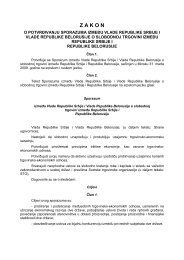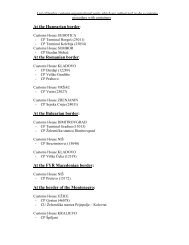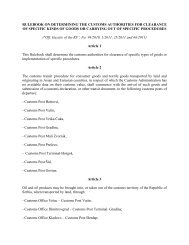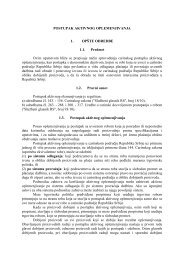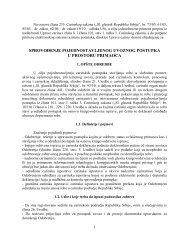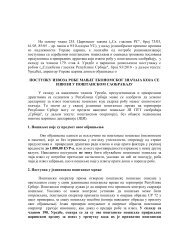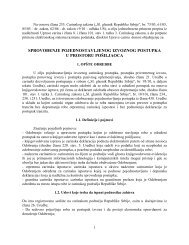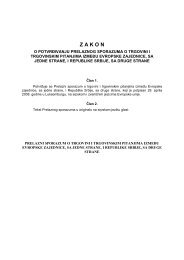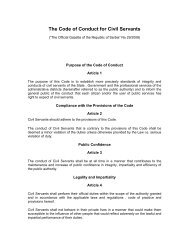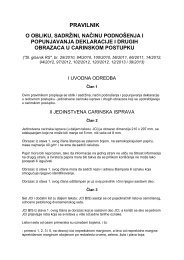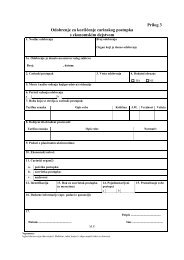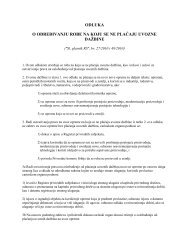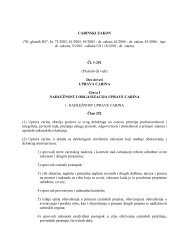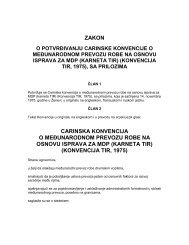- Page 1 and 2:
FREE TRADE AGREEMENTBETWEENTHE EFTA
- Page 3 and 4:
DETERMINED to implement this Agreem
- Page 5 and 6:
ARTICLE 3Territorial Application1.
- Page 7 and 8:
ARTICLE 9Basic Duties1. The basic d
- Page 9 and 10:
ARTICLE 16State Trading Enterprises
- Page 11 and 12:
production, and under such conditio
- Page 13 and 14:
CHAPTER 3PROTECTION OF INTELLECTUAL
- Page 15 and 16:
Agreement on Trade in Services (her
- Page 17 and 18:
ARTICLE 31ClarificationsIt is under
- Page 19 and 20:
6. Each Party may request at any ti
- Page 21 and 22:
eceive written submissions, includi
- Page 23 and 24:
CHAPTER 8FINAL PROVISIONSARTICLE 37
- Page 25 and 26:
3. Any EFTA State which withdraws f
- Page 27 and 28:
ANNEX IREFERRED TO IN SUBPARAGRAPH
- Page 29 and 30:
- 2 -HS CodeDescription of Products
- Page 31 and 32:
ANNEX IIREFERRED TO IN SUBPARAGRAPH
- Page 33 and 34:
- 3 -Article 3Switzerland, includin
- Page 35 and 36:
- 5 -Tariff Code Description of Pro
- Page 37 and 38:
- 7 -Tariff Code Description of Pro
- Page 39 and 40:
ANNEX IIIREFERRED TO IN PARAGRAPH 1
- Page 41 and 42:
- 2 -Tariff CodeDescription of Prod
- Page 43 and 44:
- 4 -Tariff CodeDescription of Prod
- Page 45 and 46:
- 6 -Tariff CodeDescription of Prod
- Page 47 and 48:
- 8 -Tariff CodeDescription of Prod
- Page 49 and 50:
- 10 -Tariff CodeDescription of Pro
- Page 51 and 52:
- 12 -Tariff CodeDescription of Pro
- Page 53 and 54:
- 14 -Tariff CodeDescription of Pro
- Page 55 and 56:
- 16 -Tariff CodeDescription of Pro
- Page 57 and 58:
- 18 -Tariff CodeDescription of Pro
- Page 59 and 60:
- 20 -Tariff CodeDescription of Pro
- Page 61 and 62:
- 22 -Tariff CodeDescription of Pro
- Page 63 and 64:
- 24 -Tariff CodeDescription of Pro
- Page 65 and 66:
- 26 -Tariff CodeDescription of Pro
- Page 67 and 68:
- 28 -Tariff CodeDescription of Pro
- Page 69 and 70:
- 30 -Tariff CodeDescription of Pro
- Page 71 and 72:
- 32 -Tariff CodeDescription of Pro
- Page 73 and 74:
- 34 -Tariff CodeDescription of Pro
- Page 75 and 76:
- 36 -Tariff CodeDescription of Pro
- Page 77 and 78:
- 38 -Tariff CodeDescription of Pro
- Page 79 and 80:
- 40 -Tariff CodeDescription of Pro
- Page 81 and 82:
- 42 -Tariff CodeDescription of Pro
- Page 83 and 84:
- 44 -Tariff CodeDescription of Pro
- Page 85 and 86:
- 2 -Tariff Code Description of Pro
- Page 87 and 88:
- 4 -Tariff Code Description of Pro
- Page 89 and 90:
- 6 -Tariff Code Description of Pro
- Page 91 and 92:
Tariff Code Description of Products
- Page 93 and 94:
Tariff Codeex 4016 99 97Description
- Page 95 and 96:
- 12 -Tariff Code Description of Pr
- Page 97 and 98:
Tariff Code Description of Products
- Page 99 and 100:
- 16 -Tariff Code Description of Pr
- Page 101 and 102:
- 18 -Tariff Code Description of Pr
- Page 103 and 104:
- 20 -Tariff CodeDescription of Pro
- Page 105 and 106:
Tariff CodeDescription of Products-
- Page 107 and 108:
- 24 -Tariff Code Description of Pr
- Page 109 and 110:
Tariff Code Description of Products
- Page 111 and 112:
- 28 -Tariff Code Description of Pr
- Page 113 and 114:
- 30 -Tariff Code Description of Pr
- Page 115 and 116:
- 32 -Tariff Code Description of Pr
- Page 117 and 118:
Tariff CodeDescription of Products
- Page 119 and 120:
Tariff CodeDescription of Products
- Page 121 and 122:
Tariff CodeDescription of Products
- Page 123 and 124:
- 40 -Tariff Code Description of Pr
- Page 125 and 126:
- 42 -Tariff Code Description of Pr
- Page 127 and 128:
- 44 -Tariff Code Description of Pr
- Page 129 and 130:
Tariff CodeDescription of Products-
- Page 131 and 132:
Tariff Code Description of Products
- Page 133 and 134:
Tariff CodeDescription of Products-
- Page 135 and 136:
- 52 -Tariff Code Description of Pr
- Page 137 and 138:
Tariff Codeex 8703 33 19Description
- Page 139 and 140:
Tariff Code Description of Products
- Page 141 and 142:
- 58 -Tariff Code Description of Pr
- Page 143 and 144:
Tariff CodeDescription of Products
- Page 145 and 146:
- 62 -Tariff Code Description of Pr
- Page 147 and 148:
- 2 -Tariff Code Description of Pro
- Page 149 and 150:
- 4 -Tariff Code Description of Pro
- Page 151 and 152:
- 6 -Tariff Code Description of Pro
- Page 153 and 154:
- 8 -Tariff Code Description of Pro
- Page 155 and 156:
- 10 -Tariff Code Description of Pr
- Page 157 and 158:
Tariff CodeDescription of Products
- Page 159 and 160:
Tariff CodeDescription of Products-
- Page 161 and 162:
Tariff Code Description of Products
- Page 163 and 164:
Tariff Code Description of Products
- Page 165 and 166:
Tariff Codeex 8504 40 88Description
- Page 167 and 168:
Tariff Codeex 8518 40 30Description
- Page 169 and 170:
- 24 -Tariff Code Description of Pr
- Page 171 and 172:
Tariff CodeDescription of Products
- Page 173 and 174:
- 28 -Tariff Code Description of Pr
- Page 175 and 176:
- 30 -Tariff Code Description of Pr
- Page 177 and 178:
ANNEX IVREFERRED TO IN ARTICLE 14TR
- Page 179 and 180:
- 3 -2. The Parties shall endeavour
- Page 181 and 182:
- 5 -Article 9Fees and Charges1. Fe
- Page 183 and 184:
ANNEX VREFERRED TO IN PARAGRAPH 2 O
- Page 185 and 186:
ANNEX VIREFERRED TO IN ARTICLE 24PR
- Page 187 and 188:
- 2 -(a)the Geneva Act of 1999 of t
- Page 189 and 190:
- 4 -Article 5Undisclosed Informati
- Page 191 and 192:
- 6 -TITLE IVENFORCEMENT OF INTELLE
- Page 193 and 194:
ANNEX VIIREGARDING TRANSITIONAL RUL
- Page 195 and 196:
PROTOCOL AREFERRED TO IN SUBPARAGRA
- Page 197 and 198:
- 2 -2. The EFTA States and Serbia
- Page 199 and 200: - 2 -HS Code Description of Product
- Page 201 and 202: - 4 -HS Code Description of Product
- Page 203 and 204: - 6 -HS Code Description of Product
- Page 205 and 206: - 8 -HS Code Description of Product
- Page 207 and 208: TABLE 2 OF PROTOCOL A - TARIFF CONC
- Page 209 and 210: - 3 -Tariff Code Description of Pro
- Page 211 and 212: - 5 -Tariff Code Description of Pro
- Page 213 and 214: - 7 -Tariff Code Description of Pro
- Page 215 and 216: - 9 -Tariff Code Description of Pro
- Page 217 and 218: - 11 -Tariff Code Description of Pr
- Page 219 and 220: PROTOCOL BREFERRED TO IN ARTICLE 7D
- Page 221 and 222: (iii)LIST OF APPENDICESAppendix 1 I
- Page 223 and 224: - 2 -(j)(k)(l)(m)(n)(o)(p)“chapte
- Page 225 and 226: - 4 -participant in the Euro-Medite
- Page 227 and 228: - 6 -(b)(c)materials and products h
- Page 229 and 230: - 8 -This paragraph shall not apply
- Page 231 and 232: - 10 -regarded as originating, prov
- Page 233 and 234: - 12 -one single consignment may be
- Page 235 and 236: - 14 -4. The provisions of paragrap
- Page 237 and 238: - 16 -(a)(b)(c)cumulation was appli
- Page 239 and 240: - 18 -3. The endorsement referred t
- Page 241 and 242: - 20 -4. An invoice declaration EUR
- Page 243 and 244: - 22 -Article 26Importation by Inst
- Page 245 and 246: - 24 -render the proof of origin nu
- Page 247 and 248: - 26 -whether the documents are aut
- Page 249: APPENDIX 1 TO PROTOCOL BINTRODUCTOR
- Page 253 and 254: - 5 -Example:A yarn of heading 5205
- Page 255 and 256: - 7 -(c)(d)(e)(f)(g)(h)(ij)(k)(l)(m
- Page 257 and 258: APPENDIX 2 TO PROTOCOL BLIST OF WOR
- Page 259 and 260: - 3 -HS HeadingDescription of Produ
- Page 261 and 262: - 5 -HS HeadingDescription of Produ
- Page 263 and 264: - 7 -HS HeadingDescription of Produ
- Page 265 and 266: - 9 -HS HeadingDescription of Produ
- Page 267 and 268: - 11 -HS HeadingDescription of Prod
- Page 269 and 270: - 13 -HS HeadingDescription of Prod
- Page 271 and 272: - 15 -HS HeadingDescription of Prod
- Page 273 and 274: - 17 -HS HeadingDescription of Prod
- Page 275 and 276: - 19 -HS HeadingDescription of Prod
- Page 277 and 278: - 21 -HS HeadingDescription of Prod
- Page 279 and 280: - 23 -HS HeadingDescription of Prod
- Page 281 and 282: - 25 -HS HeadingDescription of Prod
- Page 283 and 284: - 27 -HS HeadingDescription of Prod
- Page 285 and 286: - 29 -HS HeadingDescription of Prod
- Page 287 and 288: - 31 -HS HeadingDescription of Prod
- Page 289 and 290: - 33 -HS HeadingDescription of Prod
- Page 291 and 292: - 35 -HS HeadingDescription of Prod
- Page 293 and 294: - 37 -HS HeadingDescription of Prod
- Page 295 and 296: - 39 -HS HeadingDescription of Prod
- Page 297 and 298: - 41 -HS HeadingDescription of Prod
- Page 299 and 300: - 43 -HS HeadingDescription of Prod
- Page 301 and 302:
- 45 -HS HeadingDescription of Prod
- Page 303 and 304:
- 47 -HS HeadingDescription of Prod
- Page 305 and 306:
- 49 -HS HeadingDescription of Prod
- Page 307 and 308:
- 51 -HS HeadingDescription of Prod
- Page 309 and 310:
- 53 -HS HeadingDescription of Prod
- Page 311 and 312:
- 55 -HS HeadingDescription of Prod
- Page 313 and 314:
- 57 -HS HeadingDescription of Prod
- Page 315 and 316:
- 59 -HS HeadingDescription of Prod
- Page 317 and 318:
- 61 -HS HeadingDescription of Prod
- Page 319 and 320:
- 63 -HS HeadingDescription of Prod
- Page 321 and 322:
- 65 -HS HeadingDescription of Prod
- Page 323 and 324:
- 67 -HS HeadingDescription of Prod
- Page 325 and 326:
- 69 -HS HeadingDescription of Prod
- Page 327 and 328:
- 71 -HS HeadingDescription of Prod
- Page 329 and 330:
- 73 -HS HeadingDescription of Prod
- Page 331 and 332:
- 75 -HS HeadingDescription of Prod
- Page 333 and 334:
- 77 -HS HeadingDescription of Prod
- Page 335 and 336:
- 79 -HS HeadingDescription of Prod
- Page 337 and 338:
- 81 -HS HeadingDescription of Prod
- Page 339 and 340:
- 83 -HS HeadingDescription of Prod
- Page 341 and 342:
- 85 -HS HeadingDescription of Prod
- Page 343 and 344:
- 87 -HS HeadingDescription of Prod
- Page 345 and 346:
- 89 -HS HeadingDescription of Prod
- Page 347 and 348:
- 91 -HS HeadingDescription of Prod
- Page 349 and 350:
- 93 -HS HeadingDescription of Prod
- Page 351 and 352:
- 95 -HS HeadingDescription of Prod
- Page 353 and 354:
1. Exporter (Name, full address, co
- Page 355 and 356:
APPLICATION FOR A MOVEMENT CERTIFIC
- Page 357 and 358:
APPENDIX 3B TO PROTOCOL BSPECIMENS
- Page 359 and 360:
13. REQUEST FOR VERIFICATION, to 14
- Page 361 and 362:
DECLARATION BY THE EXPORTERI, the u
- Page 363 and 364:
- 2 -Norwegian versionEksportøren
- Page 365 and 366:
- 2 -Icelandic versionÚtflytjandi



